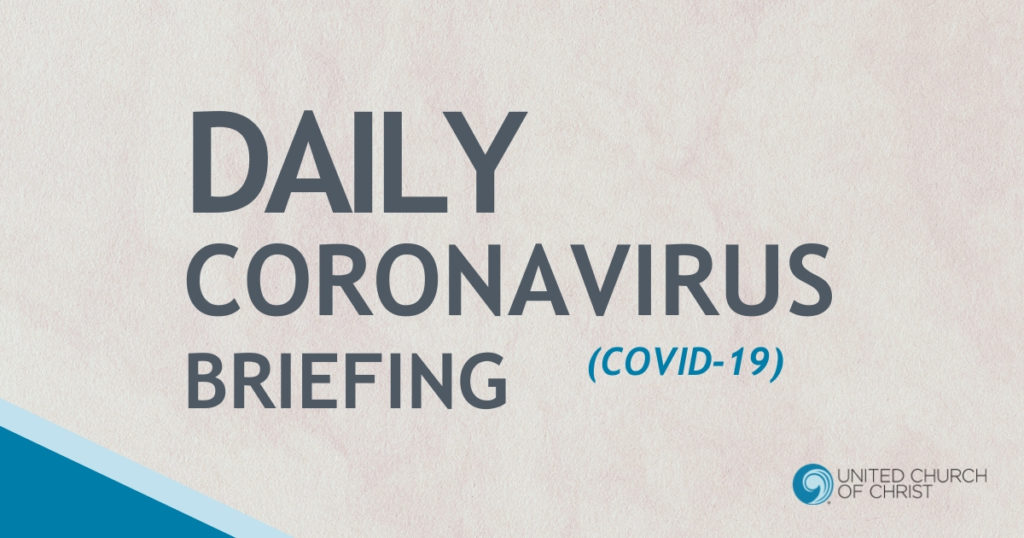COVID-19 and Millennials
United Church of Christ – Wider Church Ministries
Humanitarian Development Team
Coronavirus (COVID-19) Daily Briefing
Barbara T. Baylor, MPH – Temporary Health Liaison
Millennials and COVID-19
Are young adults among the people in your life who are feeling invulnerable to COVID-19, leaving their face masks and hand sanitizers at home and neglecting social distancing?
Here’s why they should rethink that – and why Millennials need to get on the front lines of urging their generation and younger to take COVID-19 seriously.
Current data show that Millennials (aged 26 to 40) are getting infected at a rate higher than their proportion in the population. Twenty-two percent of the population, they account for 30 percent of new COVID-19 cases, 20 percent of COVID-19 related hospitalizations and 2-4 percent of ICU admissions with severe symptoms, the Centers for Disease Control (CDC) says.
NPR confirmed that Millennials now account for a larger share of new COVID-19 infections than they did earlier in the pandemic.
The demographic shift has emerged in regions with different populations and political approaches to the pandemic, including in Washington state, California, Florida, Texas, North Carolina, South Carolina, Arizona, Wisconsin and Colorado. All these states report clusters that have a larger proportion of young adults than they had previously seen.
My own state of Georgia also has seen a surge in young people infected with COVID-19. At the beginning of June, about 15 percent of Georgia’s new cases were 18- to 29-year-olds. A few weeks later, that number has jumped to 27 percent.
What the numbers show is that people in this demographic are just as susceptible to COVID-19 as those in other age groups.
Analysts say that the trend can be explained in several ways. More people are getting COVID-19 tests than at the beginning of the pandemic. As criteria have expanded for who gets tested, so has the capacity to test. Early in the pandemic, only people with symptoms or who were seriously ill could get tested at all. Now, even as more older adults are tested, the rate of infections in younger people is climbing.
But testing is not the only explanation. Public health experts say that the increase in new cases among Millennials may be due to younger adults having the perception that they are at less risk than their parents or grandparents. They say that the increase likely is due to a shift in behavior as younger people start to move away from social distancing and consistent mask use.
To be clear, Americans aged 60-plus are still at proportionately greater risk for COVID-19 infections, hospitalization for severe illness, and death due to the virus.
Still, as there has been a spike in new cases generally across the country, the uptick in new cases by Millennials is of concern because they may be asymptomatic or mildly symptomatic and have the potential of driving community transmission.* Dr. Wafaa El-Sadr at Columbia University’s Mailman School of Public Health says this is a key metric that public health agencies should be following.
Millennials, please take up this challenge:
According to White House Coronavirus Task Force Coordinator Dr. Deborah Birx, Millennials are the core group to stop the spread of the virus because they intuitively know how to contact each other without being in a large social gathering and they’re the ones who are out and about. She noted that many young people may not experience symptoms but can still transmit the virus to older Americans. Dr. Anthony Fauci echoed this point by saying that Millennials are an important part of the active plan to contain this epidemic.
A key Millennial strategy is to enlist the aid of Millennials to mobilize the younger population through social media rather than relying on the same messaging that’s been coming from public health officials for months. What is needed is a personal approach to motivate young people to follow public health COVID-19 prevention guidance.
While some despair that Millennials are not taking COVID-19 seriously and are ignoring public health messages for the sake of “being free,” a poll conducted by the Associated Press-NORC Center for Public Affairs Research indicated reasons for hope. The poll found that Millennials have the following concerns, which can be worked with in messaging:
1. Their parents and grandparents. Making sure their parents and grandparents are safe and following social distancing practices.
2. Family and school closures. Millennials are trying to juggle working from home with the role of stand-in teacher for their children.
3. Finances. A poll from the Pew Research Center found American millennials to be the most pessimistic of any age group about the future of the economy. More young people have been laid off, and many of those still with jobs have had to take pay cuts. In general Millennials of all backgrounds are experiencing high anxiety around how COVID-19 will affect their economic realities.
4. Health Insurance. Millennials are concerned about job loss and the resulting loss of health insurance.
5. Internet. A Pew survey shows that 62 percent of young Americans between the ages of 18 and 29 view internet service as essential to their lives. An even larger majority was observed in those between the ages of 30 and 49, with 65 percent of respondents labeling internet as essential.
As more young people are becoming infected with COVID-19, it is essential for state and local health departments to report the age breakdown of COVID-19 cases. Many don’t currently release information about age with other daily metrics such as hospitalizations.
The U.S. Department of Health and Human Services (HHS) has announced New Laboratory Data Reporting Guidance for COVID-19 Testing. Beginning in August, all laboratories testing for COVID-19 will be required to report standardized information including age and race for each new case to the federal government. This requirement will help determine the burden of infection on vulnerable groups and assist with improved decision making in preventing further illnesses among Americans – and will greatly benefit the cohort of Millennials.
————
* “Community transmission” means that a person is infected by the virus but they have not been overseas recently or knowingly been in recent contact with other confirmed cases. The term basically means authorities are unable to trace the source of the infection.
Related News
Growing Weary
In December 1964 during a speech in Harlem, Fannie Lou Hamer declared: “And you can always...
Read MorePlanning for Earth Month: Resources for Congregations
April is Earth Month, and for congregations, it can be a great time to further discern how...
Read MoreBodily Autonomy Means Every-BODY
Advocacy and Action for Women's and Gender Justice Local events stir thoughts and...
Read More


